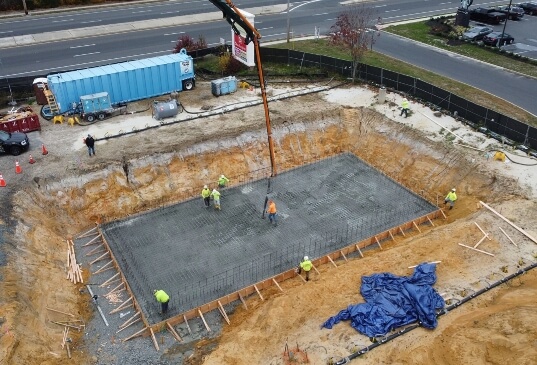Different Grades of Concrete Explained
A large part of concrete strength testing is designed to determine what grade each type is categorized as. Different varieties are graphed on a concrete strength curve, which helps contractors choose the best option for different projects. Here is a brief overview of commonly used grades in commercial construction.

This type has the lowest concrete strength. It is reserved for small residential or commercial projects, such as garden paths or decorative patio slabs, that will not see heavy foot traffic.

This is the next step up in concrete compressive strength, and suits indoor flooring and foundations, or walls for secondary buildings like residential garages and sheds.

This grade is safe to use for small foundations or driveways, and is considered a cost-effective but durable option.

This strength is the first heavy-duty concrete grade often used in heavy traffic parking lots, on-site roadways, or even public access streets.

Commercial structural projects frequently use this grade. It is featured heavily in commercial projects for exterior walls and structural components.

This is the most durable and strongest concrete available. Its primary uses include multi-story building foundations, septic tanks, and in projects where the concrete is expected to come in contact with strong chemicals.

Reach out to the pros at TG Basile to help with your next large concrete installation.
What Strength Measurements Affect Concrete Quality?
Three different varieties of force are used to determine the concreate strength measurement for each grade or variety. These include concrete compression testing, concrete flexural stress, and concrete shear strength.
Compressive stress measures the ability of the concrete object to withstand things put on top of it. This includes structural elements like walls or additional floors as well as things like vehicles in a parking lot. Flexural stress of concrete measures the forces that stretch or elongate the structure. So, compression pushes downward while flexural pressure pulls it horizontally. Shear stress comes from perpendicular opposite forces exerting pressure in two directions at once.
Tensile strength of concrete is another factor that can play into the quality of the finished project. Concrete does not have much of this in general, so it is not used for those types of construction elements. Of course, it does need some. Tensile strength is about 10% of compression strength in general.
Some structures require higher resistance to one type of stress than another. For example, a parking lot needs a lot of compression stress durability but will not experience much need for shear stress. However, the best concrete for long-lasting construction should have high ratings in all of these.
Testing Concrete Strength Against Multiple Stresses
The basic measurement used for these tests is the PSI strength of concrete. PSI stands for pounds per square inch. Air pressure is around 15 PSI, but commercial construction projects must withstand a much higher number than that. Regular concrete PSI strength is around 3000 PSI. That means a square inch of hardened concrete can handle that amount before it fails structurally in some way.
How is this compression strength tested?
The American Society for Testing & Materials creates slabs of different grades of concrete. Then, they use a carefully calibrated machine to push down or compress these slabs until failure. The measurement before any cracks, chips, or breaks occur is the PSI strength of that concrete.
Tensile and flexural strength are tested in a very similar way. In these cases, the testing machines bend or exert oppositional force on the material until it bends or breaks. They use a concrete beam instead of a slab format.
Determining the Best Concrete Option for Each Project
Concrete is used in a huge array of different residential and commercial building cases from garden pathways to multi-story parking garages. A simple home driveway will function well and last a long time with a compression strength of 2500 PSI, while a nuclear power plant containment unit needs more than 6000 PSI to perform optimally.
Expert concrete contractors like TG Basile understand the specific needs and regulatory requirements of different types of building projects. Things like concrete compression strength and tensile strength of concrete affect the usability and the long-term results. Property owners or stakeholders in commercial construction projects should trust their chosen team to get the job done right.
Contact us today to learn more about the best concrete for your commercial project!





